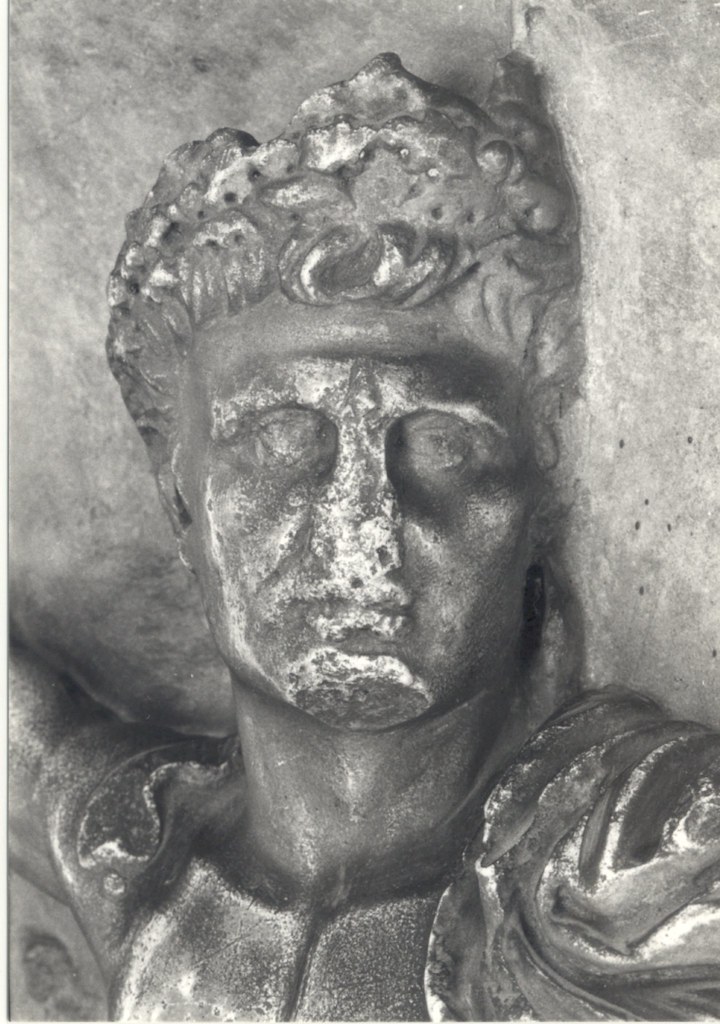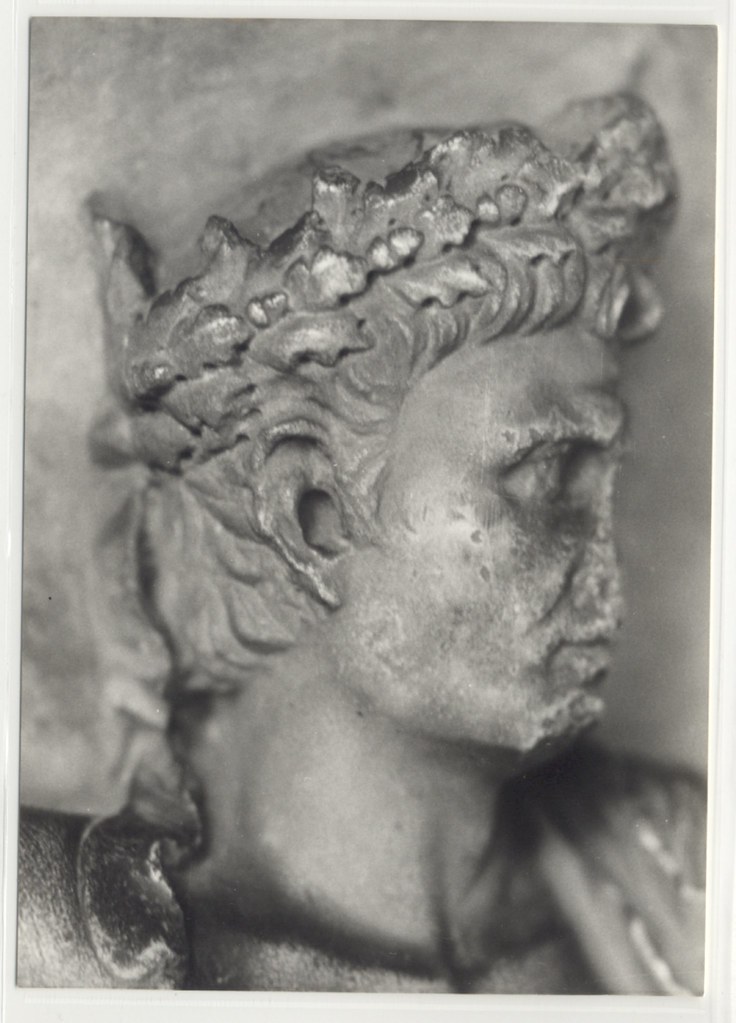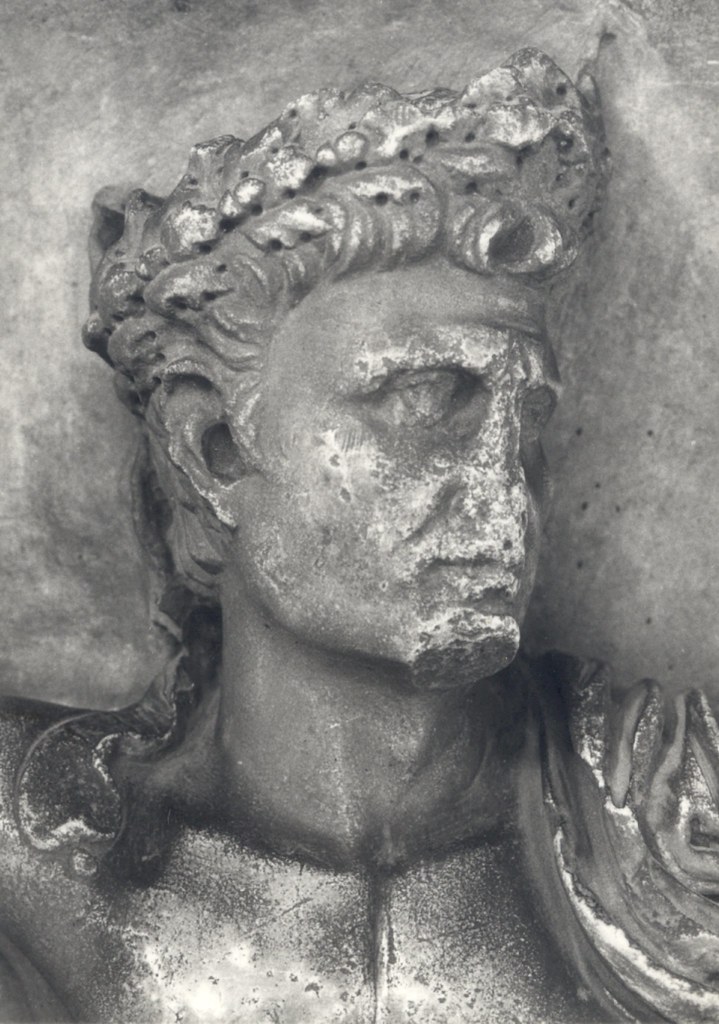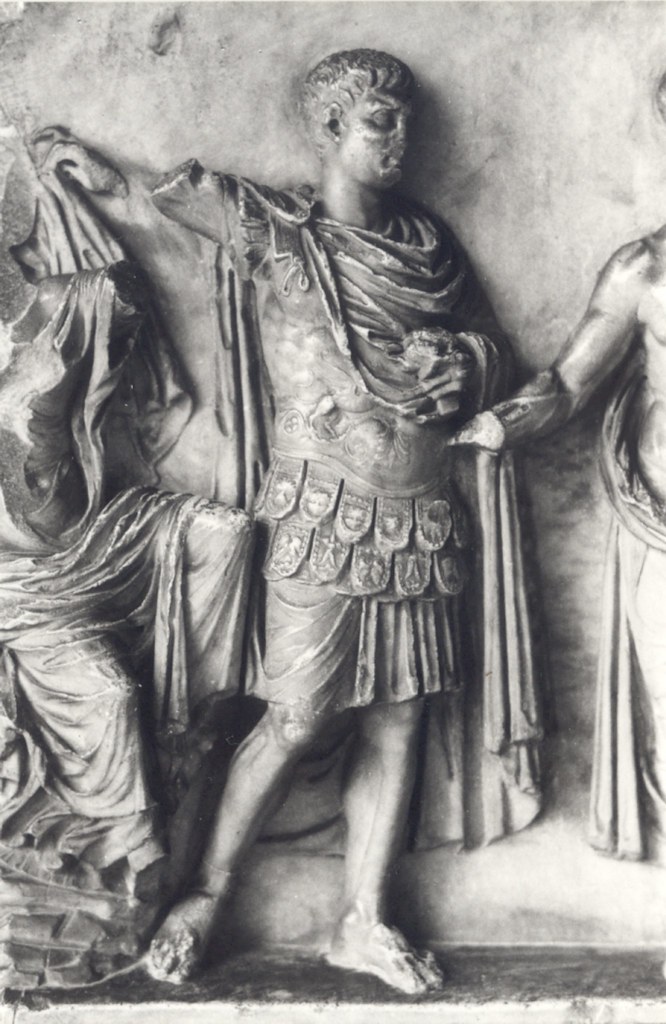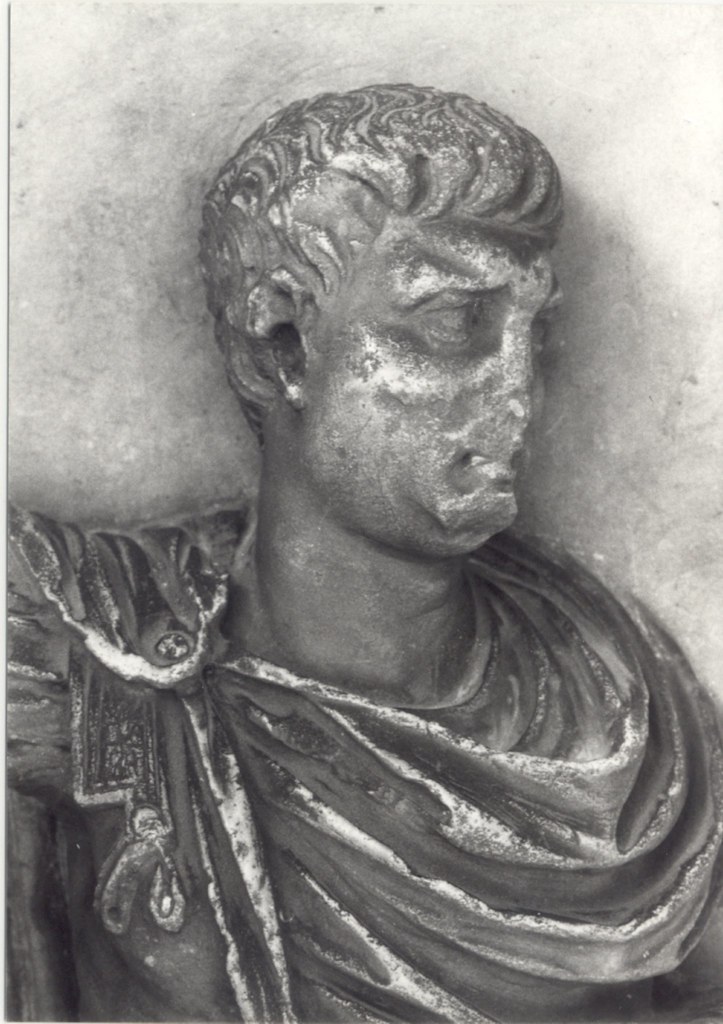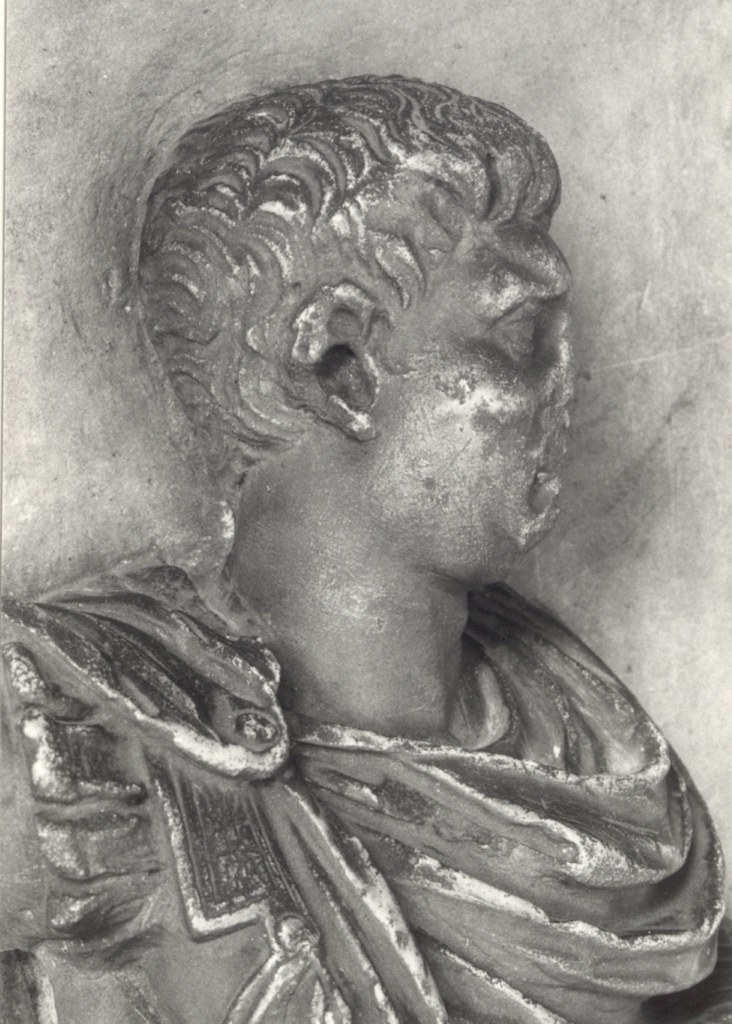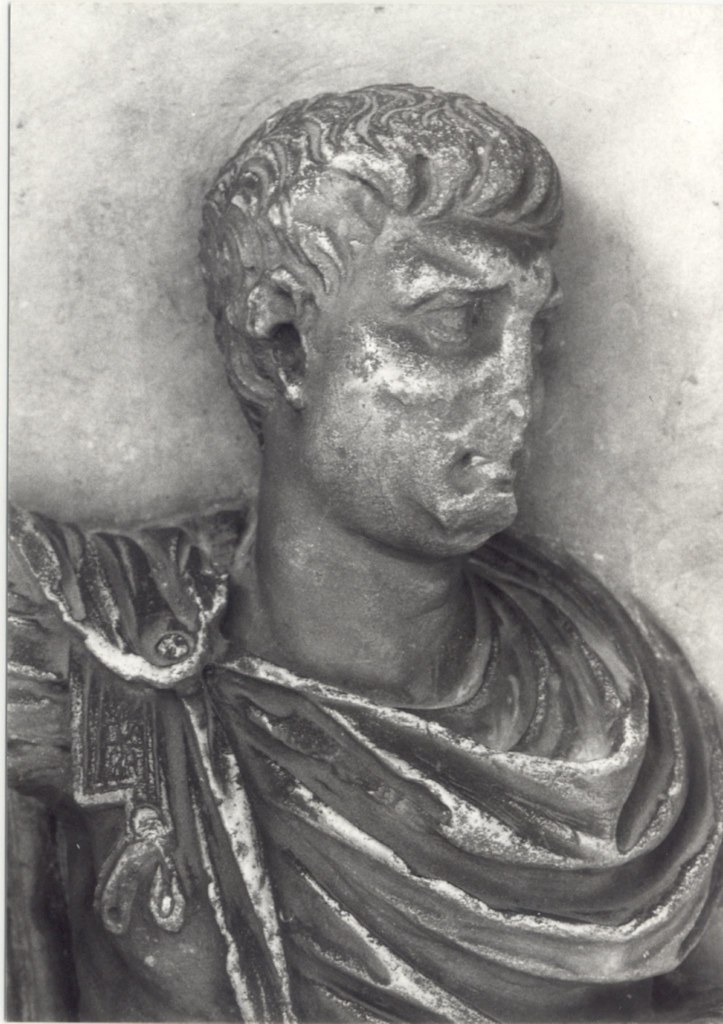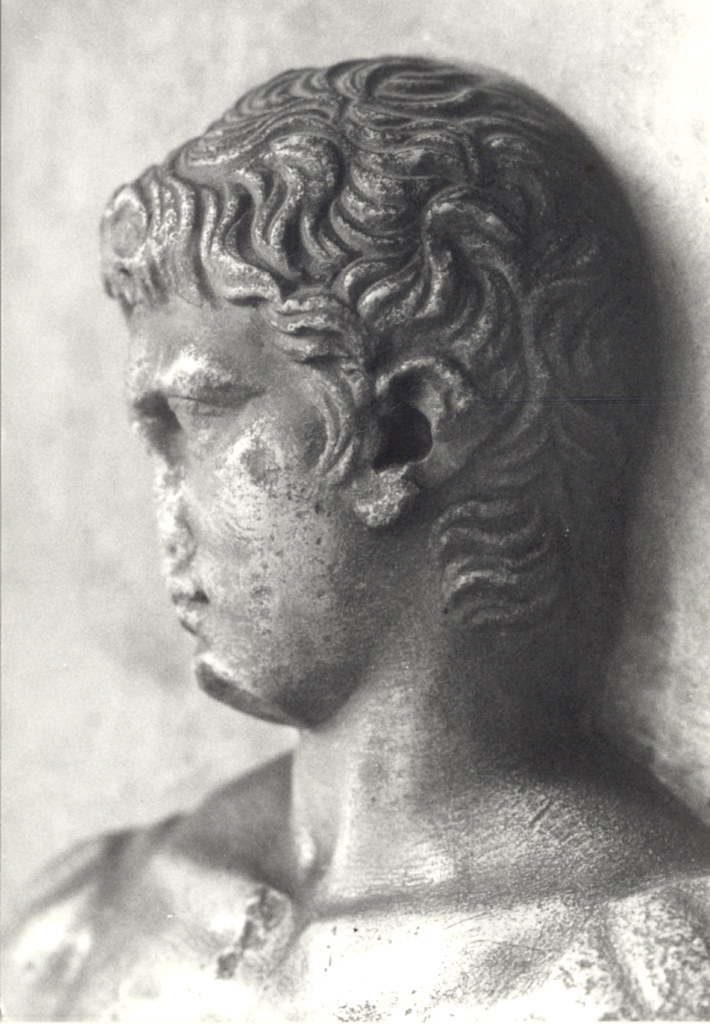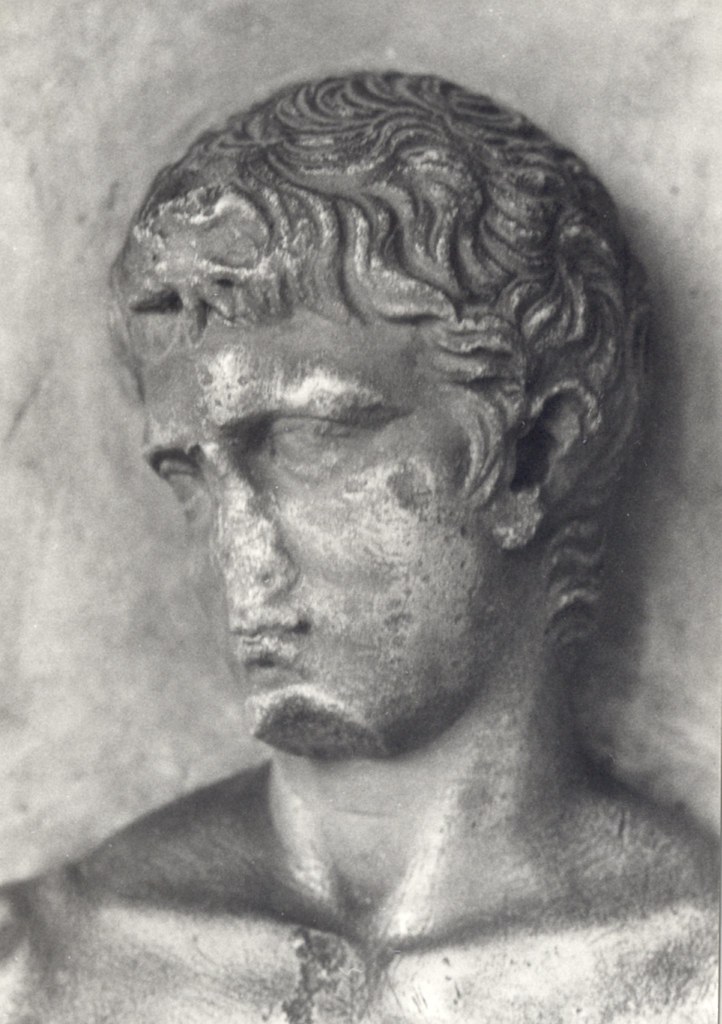Photo courtesy Prof. John Pollini
Height 1.04 m.
This is the first public relief (monument) to show the imperial family in full portrait frontality. There were republican funerary monuments that showed full frontality, but not of the imperial family. We can clearly see Augustus as Mars (Far Right) idnetified by his hairstyle and pyhsiognomy Augustus is also wearing the "Corona Civicta". (To the left) of Augustus we have Livia as Venus, Eros is on her left shoulder, and wearing a tiara. Her dress is based on Venus Genetrix of the fifth century B.C. (To the left) of Livia we have Germanicus, brother of Claudius. The figure to the left of Germanicus appears to be Drusus the elder, Patriae Claudiu. The seated figure on the (far left) has been identified as either Antonia (mother of Claudius or a representation of pietas.
Photo courtesy Prof. John Pollini
Portrait statues left to right:
Uncertain identity of seated female figure, cuirassed statue of a Julio Claudian prince (Agrippa?); statue wearing a hip mantle and shown with a star carved in relief over the forehead (Divus Julius?) Female portrait characterized as venus genetrix by the tiny figure of cupid (sometimes identified as Livia?) Augustus wearing his hip mantle and corona civica and rayed crown, with his left foot on globe; he once held a sceptre in his raised hand; in his left is preserved traces of a thunderbolt.
Usually dated to the reign of Claudius (41-54 A.D.)
Height 1.04 m.
Ravenna Musuem
There were two marble fragments found from the Claudian period? that now reside at the Museo National in Ravenna Italy. It could have been an altar or other monument, it was found near or in the mausoleum of Galla Placidia in the sixteenth century. The fragment relief was meant to depict a dynastic statuary group from the Julio Claudian dynasty. Who were these figures and what did they represent?
www.flickr.com/photos/julio-c...14320/sizes/o/
This is the first public relief (monument) to show the imperial family in full portrait frontality. There were republican funerary monuments that showed full frontality, but not of the imperial family. We can clearly see Augustus as Mars (Far Right) idnetified by his hairstyle and pyhsiognomy Augustus is also wearing the "Corona Civicta". (To the left) of Augustus we have Livia as Venus, Eros is on her left shoulder, and wearing a tiara. Her dress is based on Venus Genetrix of the fifth century B.C. (To the left) of Livia we have Germanicus, brother of Claudius. The figure to the left of Germanicus appears to be Drusus the elder, Patriae Claudiu. The seated figure on the (far left) has been identified as either Antonia (mother of Claudius or a representation of pietas.
Photo courtesy Prof. John Pollini
Portrait statues left to right:
Uncertain identity of seated female figure, cuirassed statue of a Julio Claudian prince (Agrippa?); statue wearing a hip mantle and shown with a star carved in relief over the forehead (Divus Julius?) Female portrait characterized as venus genetrix by the tiny figure of cupid (sometimes identified as Livia?) Augustus wearing his hip mantle and corona civica and rayed crown, with his left foot on globe; he once held a sceptre in his raised hand; in his left is preserved traces of a thunderbolt.
Usually dated to the reign of Claudius (41-54 A.D.)
Height 1.04 m.
Ravenna Musuem
There were two marble fragments found from the Claudian period? that now reside at the Museo National in Ravenna Italy. It could have been an altar or other monument, it was found near or in the mausoleum of Galla Placidia in the sixteenth century. The fragment relief was meant to depict a dynastic statuary group from the Julio Claudian dynasty. Who were these figures and what did they represent?
www.flickr.com/photos/julio-c...14320/sizes/o/
This is the first public relief (monument) to show the imperial family in full portrait frontality. There were republican funerary monuments that showed full frontality, but not of the imperial family. We can clearly see Augustus as Mars (Far Right) idnetified by his hairstyle and pyhsiognomy Augustus is also wearing the "Corona Civicta". (To the left) of Augustus we have Livia as Venus, Eros is on her left shoulder, and wearing a tiara. Her dress is based on Venus Genetrix of the fifth century B.C. (To the left) of Livia we have Germanicus, brother of Claudius. The figure to the left of Germanicus appears to be Drusus the elder, Patriae Claudiu. The seated figure on the (far left) has been identified as either Antonia (mother of Claudius or a representation of pietas.
Could it be the following:
Caption:
Julio-
Claudian apotheosis. Marble
relief plaque depicting the
apotheosis of the
Julio-
Claudian family, from
Ravenna: front panel. From left to right:
Drusus the Elder (?),
Germanicus (?),
Antonia (with
Eros, indicating identification as
Venus),
Augustus (wearing corona civica, with attributes of Zeus). ca. 50 AD.
Ravenna, Museo Nazionale.?
Andreae 1983, 54-56, 63, figs. 122-24, 126-30, showing the
 Ravenna relief
Ravenna relief 
(fig.

at fig. 132; Andreae 1982, 203-6, fig. at p. 205; identical crown, dress slightly modified to the
diva type developed by
Caligula for
Drusilla (i.e., the triangular "apron"; see Rose 1987, s.v.
Drusilla), but
Amor here stands upon
Antonia 's hand at hip level, leaning on her left shoulder and looking up in her
face.
31. See pp. 33, 228 n. 92. The
Venus: Gros 1976a, 162, 168; the
Mars: Gros 1976a, 166-68; Zanker 1988, 199, 201-3, 347.
32. The problematic Belvedere and Vicus Sandaliarius altars are sometimes held to depict
Venus. Belvedere
altar: Fullerton 1985, 482; Zanker 1988, 222, s.v. fig. 17. Vicus Sandaliarius
altar: Zanker 1988, 129, fig. 101; Rose 1987, cat.
Rome 03; Hölscher 1984c, 27f.; p. 242 n. 126 and p. 247 n. 38 below (epiphany compositions). On both also Pollini 1987, 30f, nn. 65f; Zanker 1969, 209-10. The Belvedere female who watches a chariot
apotheosis may be
Venus, but Rose has convinced me that the Vicus Sandaliarius female is a human priestess rather than
Ceres,
Vesta, etc.
33. Fittschen 1976, 175-21O; Zanker 1988, fig. 178.
34. Zanker alone in 1969 noted the BR
Venus, grouping it with the Temple of
Mars Ultor pediment (fig. 9b), the
 Ravenna relief
Ravenna relief 
(fig. 8), and the Belvedere
altar "Venus," not distinguishing between
chiton and tunic figures.
35. The list in
LIMC II (1984), s.v. "Aphrodite," sec. 19.A.I.d, is too brief., like the rest of the Aphrodite section, it is arbitrary in citing Roman (
Venus) types.
36. The tunicate
Venus type was adapted on the Augustan "Actium relief" series now in
Budapest for the figure of a goddess with
cornucopia, baby, and slipped sleeve; Simon 1986, fig. 35.
37. Not adduced by Fittschen 1979. Fittschen 's important article established that the half-naked hero seen here, on the
Algiers relief (fig. 6), on Augustan coinage is
Divus Julius, quoted for
Germanicus on the
 Ravenna relief
Ravenna relief 
(fig. 8). This figure Fittschen and others attribute to the Temple of
Divus Julius in the
Forum; however, on coins of 37-34 B.C. that statue is visible in its temple as a figure
capite velato holding up a
lituus .
RRC 540/1-2;
Kais. Aug. 1988, cat. 308 (
Trillmich);
Kent 1978, cat. 118; Simon 1986, fig. 108
38. Thus also the
Venus to be
restored on the Sorrento base cannot have had
Amor on her shoulder, as he stands by
Mars; see fig. 15b and p. 220 n. 13.
39. Zanker 1972, 9-10; Zanker 1988, 81, 97, 266, and figs. 62b (coin), 65 (
terracotta antefix), 208 (
lamp), 214 (bronze stand); Weinstock 1971, 50-51; Hölscher 1967, 9-17 (the BR cup at p. 9); Hölscher 1984a, 26; and Hölscher in
Kais. Aug . 1988, 374 and figs. 170-72, s.v. cat. 207 (
Campana plaque series from around
Rome showing
Augustus '
Victoria with a
standard and Capricorns). Hölscher (1984a, 9-10) notes: "Sie . . . müssen eher als Ausdruck loyaler Gesinnung gewisser Privatpersonen gedeutet werden"; cf. also Zanker 1988, 265-78.


